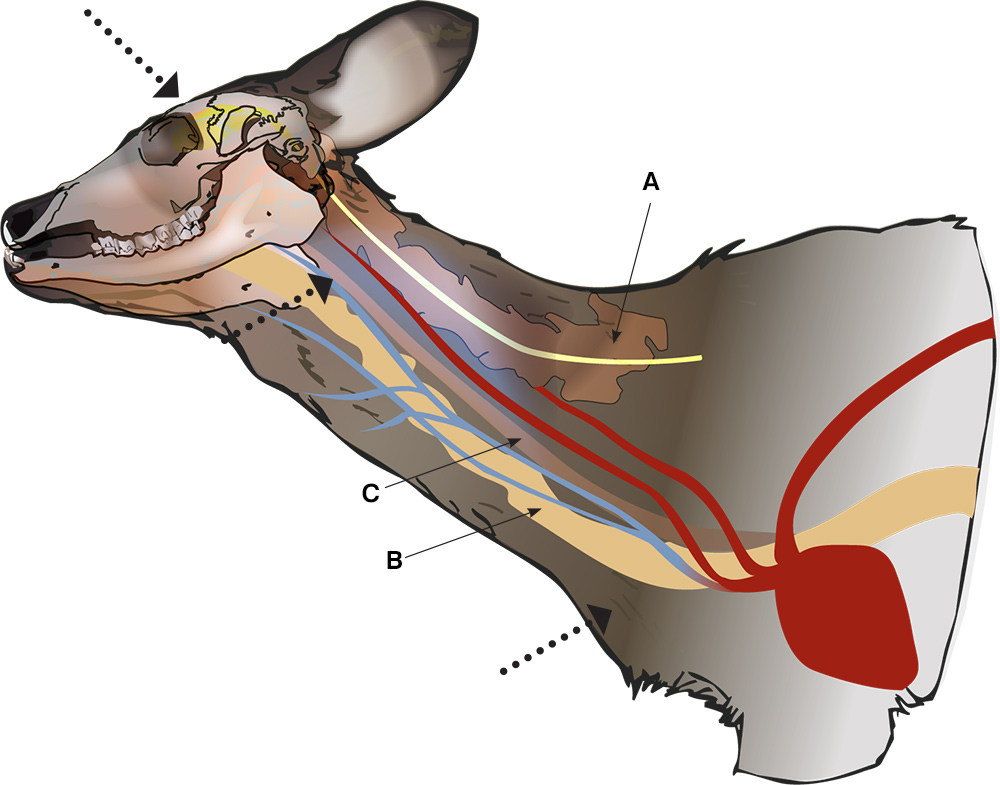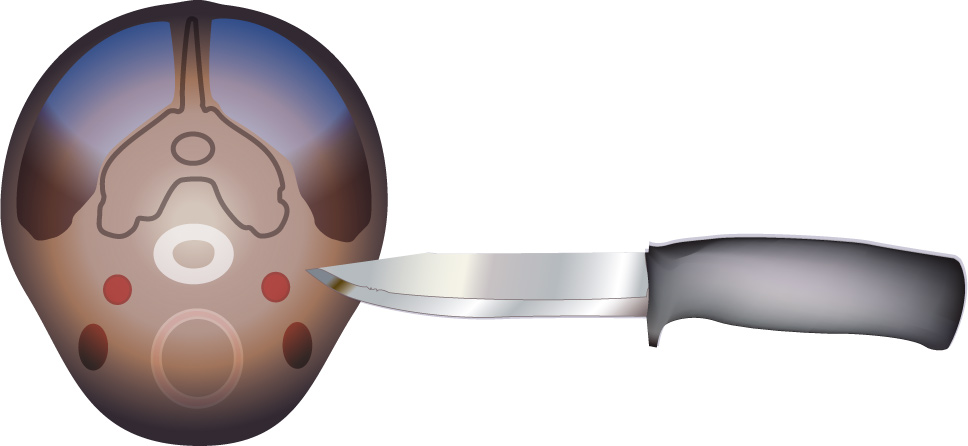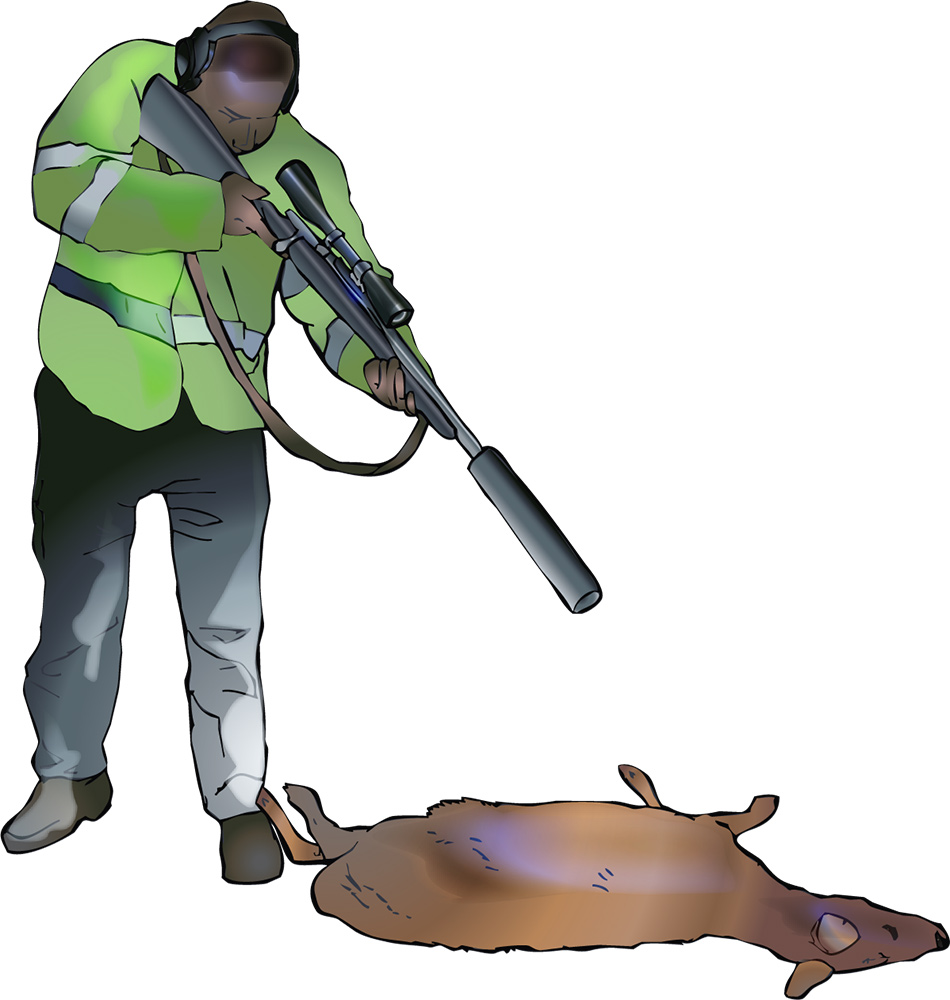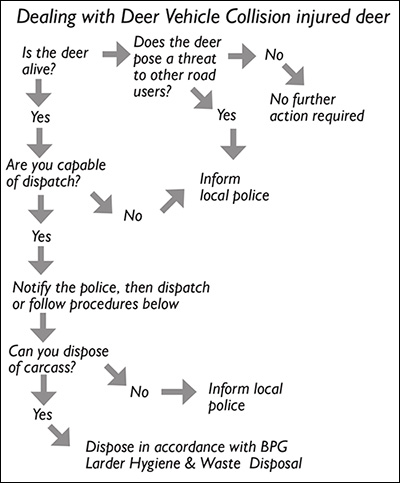
A: neck vertebrae; B: trachea; C: oesophagus; (arrow above skull represents the line of shot at right angles to forehead, down through the brain stem. Use of Knife. Humane Slaughter. In the field situation, the most practical method of bleeding is to make a deep, transverse cut across the animal’s throat at the angle of the jaw (see dotted line). Cut deeply, severing the blood vessels, trachea and oesophagus, until the blade of the knife touches the spine. There should be two powerful jets of blood from the carotid arteries and a flow from the jugular veins. The heart may continue to pump until the carcass is ex-sanguinated. To carry out this task effectively, the operator needs a sharp knife with a blade at least 120mm (five inches) long. copyright: Humane Slaughter Association
Aim
This guide aims to provide advice on the most appropriate procedures for the humane dispatch of injured deer.
Legal issues
Section 25 of the Deer (Scotland) Act 1996 exempts individuals from being guilty of any offences involving the taking or killing of deer at any time if it is done for the purpose of preventing suffering by:
- an injured or diseased deer; or
- by any deer calf, fawn or kid deprived, or about to be deprived, of its mother, or
- a deer which is starving and which has no reasonable chance of recovering.
If killing deer for the purposes described above you may use a firearm/ammunition that would otherwise be prohibited. Ref: Deer (Firearms etc.) (Scotland) order 1985 which details the legal weapons and ammunition combinations for the culling of uninjured deer is not applicable.
- To ensure humane dispatch no rifle of less than a minimum calibre of .22, or a shotgun of a gauge no less than .410 should be used.
Ref: Wild Mammals (Protection) Act 1996.
The act of slaughtering or killing an animal must be carried out without causing unnecessary suffering.
General Principles
Situation Assessment
A situation assessment must be carried out as to if, how and when to dispatch. The assessment should take into account factors such as risk to the safety of the operator, public safety and sensitivities, deer welfare and operator competency.
Safety
- Ensure that a Risk Assessment is undertaken before carrying out any humane dispatch activity.
- Approach and handle injured animals with caution. An immobile injured deer may still be capable of leg or head movement. Be aware of the potential risk of injury to yourself and to those in close proximity, particularly from sharp antlers or hooves.
- Be aware of the risks to public safety particularly regarding:
• Use of firearms or other dispatch equipment;
• Deer carcasses posing a threat to other road users;
• Risks of Deer Vehicle Collision (DVC) deer carcasses entering human food chain.
Welfare
The aim of the dispatcher should be to carry out a single action resulting in rapid loss of conciousness and death, without causing unnecessary suffering.
- Injured animals should be approached carefully and quietly in order to assess the extent of injuries and to minimise stress and alarm.
- All deer incapacitated from their injuries should be dispatched. The welfare implications of transporting injured wild deer for veterinary treatment/rehabilitation are such that this should not be considered a practical option.
- Where an injured female deer is believed to have dependent offspring, carry out an assessment taking into account the extent and seriousness of injuries. Where possible, ensure any dependent young are also dispatched. For information on the dependency period, see BPGs for Ecology & Behaviour.
Operator Competency
- Practitioners should only attempt to carry out humane dispatch (using any method) if they have the necessary skills/training/experience.
Reasons for carrying out humane dispatch

Ideal head shot placement.
Under what circumstances would you dispatch?
- Wounded (i.e. as a result of inaccurate shot placement);
- Diseased;
- Injured (including DVC)
- Trapped.
- If a deer is dispatched on ground where you do not have deer control rights (e.g. an injured deer that has moved onto neighbouring ground), ensure that the owner/occupier is informed and has given permission to remove the carcass, or is informed as soon as possible thereafter.
Dispatching wounded deer, diseased or injured deer encountered during deer management activities.
Ensuring that you have a good understanding of best practice as it relates to the use of firearms and shot placement will go a long way to helping you shoot accurately .
However, occasionally human or mechanical error will result in a deer being wounded and the need for humane dispatch
- Any deer encountered during deer management activities displaying serious injuries or debilitating abnormalities should be dispatched.

knife is pushed in here and then out through front of throat
Dispatching trapped, but uninjured deer
There may be circumstances where deer become trapped but are uninjured. Examples range from deer caught in a fence to deer trapped in a fenced corridor or garden. In such cases an assessment of the specific circumstances should determine whether release or humane dispatch is appropriate.
- Be aware of the risks to public safety of moving or releasing a deer into an area where it may pose a threat to public safety
Methods of dispatch
The method used should be appropriate to the specific circumstances of each case, and will depend on operator and public safety, the competency of the operator using the appropriate method and taking into account the time to dispatch. The method used will also depend on whether the deer is mobile or immobile.
Use of a firearm
Shooting is the preferred method of dispatch, provided it is safe to do so and has been authorised , where appropriate, by the Police.***
“Firearm” in the context of this guides includes: Centre-fire high velocity rifles, .22 Rim-fire rifles, shotguns, specialist pistols and humane slaughtering instruments.
- Safe use of firearms: ensure that an appropriate risk assessment for any activities involving the use of firearms has been carried out. (See safe use of firearms)
- Practitioners should hold the necessary firearms, and their firearm certificates should not preclude their use for the humane dispatch of deer.
Criminal Justice Act 1988, Criminal Law (Consolidation) (Scotland) Act 1995 & Violent Crime Reduction Act 2006. It is illegal to have any sharply pointed or bladed instrument in your possession, in a public place without good reason or lawful authority. Good reason’ for carrying a knife may be shown by occupation as a farmer, estate manager, recreational stalker, expecting to need a knife whilst pursuing a lawful activity. There is an exemption in law for folding pocket knives. These must have cutting edges of less than three inches and do not lock. Recent case authority dictates that a folding pocket knife “must be foldable at all times
Specialist Alternative Methods

Ensure there is a safe background
There will be situations where it is not appropriate to use a firearm due to safety considerations or due to the time it would take to get someone to the scene with the appropriate weapon.
Other commonly used methods include:
- Drugs. This method can only be administered by qualified individuals such as vets. Those administering drugs are responsible for ensuring that carcasses do not enter the food chain and are disposed of safely.
- Captive Bolt. This is a specialist instrument generally used by trained slaughter person. For further information and guidance on the use of captive-bolts contact the Humane Slaughter Association.*
- Use of a Knife. Where no suitable alternative is available a knife may be used to dispatch an injured deer, but should only be considered if the operator is experienced in using this method.
- Under current law ensure you have “just cause” for carrying a knife in a public place (The Prevention of Crime Act 1953, The Criminal Justice Act 1988).
- Ensure the deer is safe to approach. Only proceed if satisfied that using a knife does not endanger the operator.
- Operators should be aware of the dangers of physically handling injured deer, particularly antlered male deer.
- Use a sharp knife with a fixed blade at least 5 inches (120mm) long.
Ensuring Death

- Once the humane dispatch procedure has been performed, check for an eye reflex to make sure the animal is dead. Repeat the humane dispatch procedure if required.
Touch the eye surface and look for a reflex-if none, the animal is dead or unconscious and nearly dead. The eyes will be open and appear glassy. Closed or squinted eyes may indicate that the animal is conscious and still alive.
Disposing of the Carcass
- Ensure that the person responsible for disposal of the carcass is identified and is aware of the need to remove it.
Dispatching DVC injured deer: general
- Before dispatching a Deer Vehicle Collision (DVC) injured deer where the general public are present or in close proximity, ensure the police have been notified. This may help mitigate against possible allegations of offences such as wreckless discharge of a firearm, or causing fear and alarm.
- If carrying out dispatch on a public road, ensure the Police have been notified in advance.
- As a safeguard against accusations of offences and/or malpractice, the person dispatching the deer should complete an accident report form, taking note of the police officer(s) and any member(s) of the public present.
Dispatching immobile DVC injured deer
- Where an injured deer has been found suffering injuries which have rendered it immobile, an on-site situation assessment should be made on the most appropriate method to be used to humanely dispatch it.**
Dispatching mobile DVC injured deer
Where a deer has been known to have been injured through an DVC, but is still mobile, an assessment as to the extent of its injuries must be made.*** In DVC’s where deer are believed to have sustained minor injury no further action need be taken. An obvious example would be if the deer was just clipped by a vehicle, remained on its feet, and made off showing no signs of being injured.
- If a DVC injured deer has moved from the road on to neighbouring land the landowner should be notified. When reporting a mobile DVC injured deer to the Police provide a clear description of the location (six fig grid reference where possible). The Police officer dealing with the incident should then contact the landowner(s)/ occupier(s) on whose land the deer is believed to be. If the landowner is in a position to dispatch he/she should do so.
- Where an injured mobile deer has disappeared in to a concealing habitat, such as woodland a trained dog will be required to secure it. If the owner /occupier has access to a trained dog and handler capable of tracking and securing the wounded deer, this person should be contacted immediately. This is very much a specialist area of dog work and only dogs specifically trained and proven in the field should be used (see Use of dogs)
- Although under section 25 of the Deer (Scotland) Act an injured deer can be killed with a weapon other than those normally allowed. Any nominated individual setting out with the sole purpose of securing a mobile injured deer should, where practical, use the rifle/ammunition combinations described in BPG ‘Rifles and Ammunition’.
Carcass removal
- The controller should be aware that the carcass legally belongs to the owner of the ground upon which it lies. The carcass should not be removed without the consent of the landowner
- Where a carcass presents a threat to road users, it is the responsibility of the police to remove that threat.
- Ensure that carcasses of deer euthanased by drugs are disposed of appropriately so as to avoid entry into the human/animal food chain.*****
- Where the carcass is on the roadside, within the ownership of Local Authority, they would normally be responsible for it’s removal.
- Subject to approval of the landowner, the person dispatching may remove and dispose of the carcass.
Insurance
- All persons involved in deer management should consider having adequate public liability cover.
Practitioners who regularly dispatch DVC injured deer
- Practitioners specialising in the humane dispatch of DVC deer should have the necessary experience, equipment (such as high visibility clothing), training and where possible formal proof of competence such as Deer Stalking Certificate Level 2 and/or be on the SNH Fit & Competent Register.******
Further reading : BDS/BASC Road Traffic Accidents and the Humane Dispatch of Deer-an advice note available directly from BDS or BASC (see BPG Useful Contacts for contact information).
